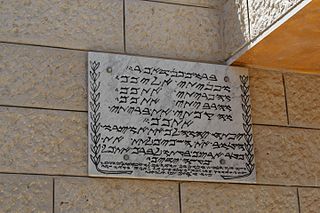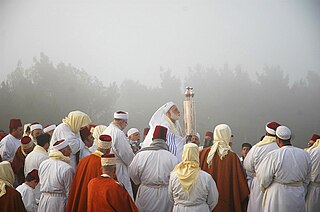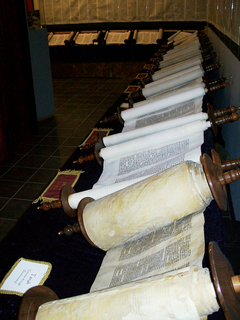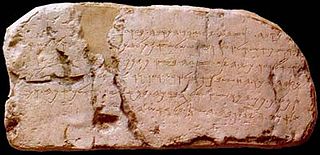The ancient Aramaic alphabet was adapted from the Phoenician alphabet and became a distinct script by the 8th century BC. It was used to write the Aramaic language and had displaced the Paleo-Hebrew alphabet, itself a derivative of the Phoenician alphabet, for the writing of Hebrew. The letters all represent consonants, some of which are also used as matres lectionis to indicate long vowels.
The Hebrew alphabet, known variously by scholars as the Jewish script, square script, and block script, is an abjad script used in the writing of the Hebrew language and other Jewish languages, most notably Yiddish, Judeo-Spanish, Judeo-Arabic, and Judeo-Persian.
The Pentateuch is the first part of the Bible, consisting of Genesis, Exodus, Leviticus, Numbers, and Deuteronomy.

The Samaritan religion, also known as Samaritanism, is the national religion of the Samaritans. The Samaritans adhere to the Samaritan Torah, which they believe is the original, unchanged Torah, as opposed to the Torah used by Jews. In addition to the Samaritan Torah, Samaritans also revere their version of the Book of Joshua and recognize some Biblical figures, such as Eli.

The Samaritans (; Samaritan Hebrew: ࠔࠠࠌࠝࠓࠩࠉࠌ, translit.Shamerim are an ethnoreligious group originating from the Israelites of the Ancient Near East.

The Hebrew Bible, which is also called the Tanakh or sometimes the Mikra, is the canonical collection of Hebrew scriptures, including the Torah. These texts are almost exclusively in Biblical Hebrew, with a few passages in Biblical Aramaic instead. The Hebrew Bible is also the textual source for the Christian Old Testament. The form of this text that is authoritative for Rabbinic Judaism is known as the Masoretic Text (MT) and it consists of 24 books, while the translations divide essentially the same material into 39 books for the Protestant Bible.

The Samaritan Pentateuch, also known as the Samaritan Torah, is a text of the first five books of the Hebrew Bible, written in the Samaritan alphabet and used as scripture by the Samaritans. It constitutes their entire biblical canon.

The Phoenician alphabet is an alphabet consisting of 22 consonant letters only, leaving vowel sounds implicit, although certain late varieties use matres lectionis for some vowels.
Samaritan Hebrew is a reading tradition used liturgically by the Samaritans for reading the Ancient Hebrew language of the Samaritan Pentateuch, in contrast to Biblical Hebrew.
The Canaanite languages, or Canaanite dialects, are one of the three subgroups of the Northwest Semitic languages, the others being Aramaic and Amorite. They were spoken by the ancient Semitic people of the Canaan and Levant regions, an area encompassing what is today Israel, Jordan, Sinai, Lebanon, Syria, the Palestinian territories and also some fringe areas of southern Turkey and the northern Arabian Peninsula. The Canaanites are broadly defined to include the Israelites, Phoenicians, Amorites, Ammonites, Moabites, Edomites, Suteans, Ekronites and Amalekites. The Canaanite languages continued to be everyday spoken languages until at least the 4th century CE. Hebrew is the only living Canaanite language today, having remained in continuous use by many Jews well into the Middle Ages as a liturgical language, it also remained a liturgical language among Samaritans, and as a literary language and for commerce between disparate diasporic Jewish communities. It was then revived by Jews as an everyday spoken language in the late 19th and early 20th centuries and became the main language of the Jews of Palestine and later the State of Israel.

Biblical Hebrew, also called classical Hebrew, is an archaic form of Hebrew, a language in the Canaanite branch of Semitic languages, spoken by the Israelites in the area known as Israel, roughly west of the Jordan River and east of the Mediterranean Sea. The term "Hebrew" was not used for the language in the Bible, which was referred to as שפת כנען or יהודית, but the name was used in Greek and Mishnaic Hebrew texts.

The Paleo-Hebrew alphabet, also spelled Palaeo-Hebrew alphabet, also known as Proto-Hebrew, was the script used in the historic kingdoms of Israel and Judah, specifically when recording the Hebrew language. Proto-Hebrew, like the Phoenician alphabet, is a slight regional variant and immediate continuation of the Proto-Canaanite script used throughout Canaan in the Late Bronze Age. Hebrew is attested epigraphically from about the 10th century BCE, and no extant "Phoenician" inscription is older than 1000 BCE. The Phoenician language, Hebrew language, and all their sister Canaanite languages were largely indistinguishable dialects before that time. The Paleo-Hebrew alphabet is an abjad of 22 (consontantal) letters. Use of the term "Paleo-Hebrew alphabet" is due to a 1954 suggestion by Solomon Birnbaum, who argued that "[t]o apply the term Phoenician to the script of the Hebrews is hardly suitable".
The Samaritans are an ethnoreligious group of the eastern Mediterranean region, originating from connection with ancient Samaria.
In a right-to-left, bottom-to-top script, writing starts from the right of the page and continues to the left. This can be contrasted against left-to-right writing systems, where writing starts from the left of the page and continues to the right.

The Tetragrammaton, is the four-letter Hebrew word יהוה, the name of the biblical God of Israel. The four letters, read from right to left, are yodh, he, waw and he. While there is no consensus about the structure and etymology of the name, "the form Yahweh is now accepted almost universally".

Ktav Ashuri is the traditional Hebrew language name of the Hebrew alphabet, used to write both Hebrew and Aramaic.

The Hebrew alphabet is a development from the Aramaic alphabet taking place during the Persian, Hellenistic and Roman periods . It replaced the so-called Paleo-Hebrew alphabet which was used in the earliest epigraphic records of the Hebrew language.
Biblical Hebrew orthography refers to the various systems which have been used to write the Biblical Hebrew language. Biblical Hebrew has been written in a number of different writing systems over time, and in those systems its spelling and punctuation have also undergone changes.
This is a part of Hebrew literature
The earliest known precursor to Hebrew is an inscription in Ancient Hebrew is the Khirbet Qeiyafa Inscription, if it can indeed be considered Hebrew at that early a stage. By far the most varied, extensive and historically significant body of literature written in the old Classical Hebrew is the canon of the Hebrew Bible, but certain other works have survived as well. It was not unusual for ancient narratives, poetry and rules to have been transmitted orally for several generations before being committed to writing. Before the Aramaic-derived modern Hebrew alphabet was adopted circa the 5th century BCE, the Phoenician-derived Paleo-Hebrew script was used instead for writing, and a derivative of the script still survives to this day in the form of the Samaritan script.

Paleo-Hebrew Leviticus scroll, known also as 11QpaleoLev, is an ancient text preserved in one of the Qumran group of caves, and which provides a rare glimpse of the script used formerly by the nation of Israel in writing Torah scrolls during its preëxilic history. The fragmentary remains of the Torah scroll is written in the Paleo-Hebrew script and was found stashed-away in a cave at Qumran, showing a portion of Leviticus. The scroll is thought to have been penned by the scribe between the late 2nd-century BCE to early 1st-century BCE, while others place its writing in the 1st-century CE.














